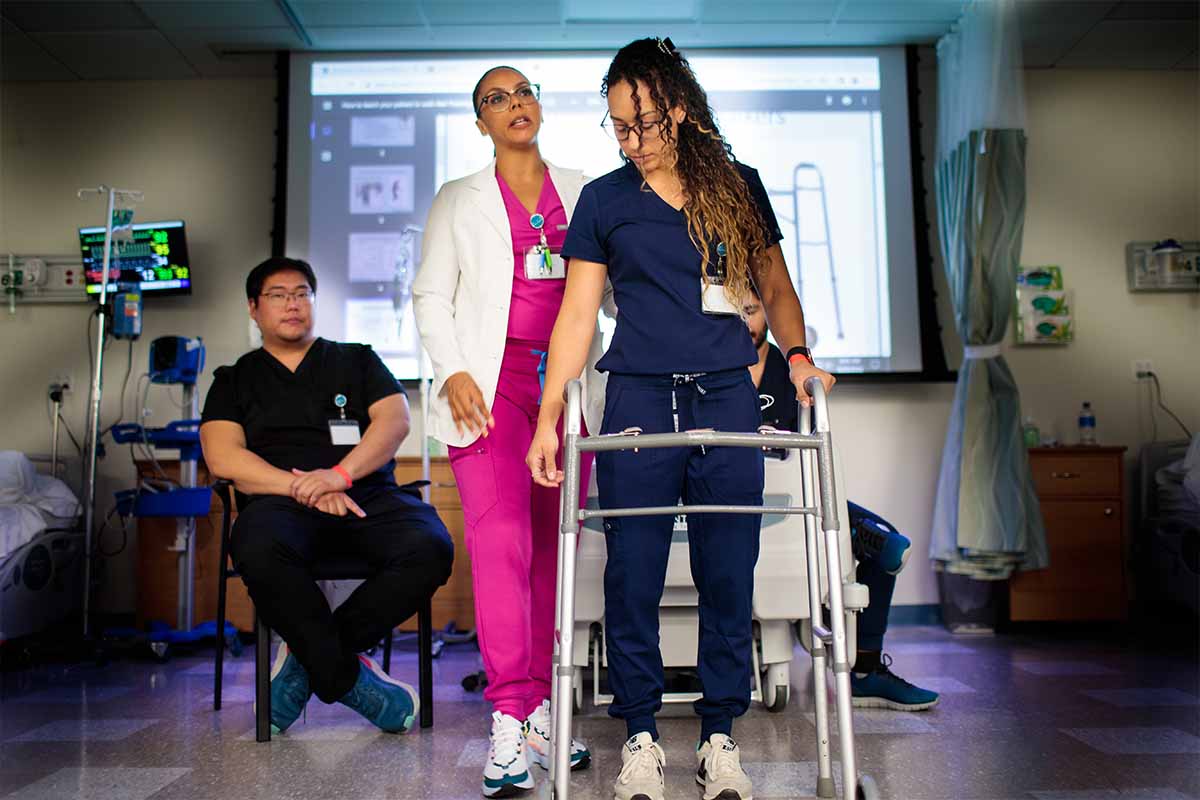
Caring for children is a noble endeavor. As is a career in nursing. When you combine the two, you find a special person trained as a pediatric registered nurse, privileged to help children develop from infancy through adolescence into healthy young adults.
Let’s explore how to become a pediatric nurse. We’ll review what the job entails, available opportunities and the steps to becoming a pediatric nurse practitioner.
What Is a Pediatric Nurse?
Pediatric nurses provide comprehensive healthcare to infants, children and teens, monitoring their rate of development.1
What is a pediatric nurse skilled at doing? Firstly, they’re capable of addressing the medical needs of children in an empathetic way. They communicate with the child and family as they oversee their healthcare over time. Through advanced specialized training from a graduate nursing program, registered nurses (RNs) can tailor their nursing skill set to focus on the unique needs of children.
What Do Pediatric Nurses Do?


Working closely with doctors, pediatric registered nurses manage multiple levels of primary care, such as recording patients’ medical histories, assisting with well-child exams, administering immunizations and treating illnesses. As children’s physical and cognitive capacities are continually developing, pediatric registered nurses must adjust their approach and care plans to meet each child’s needs on the child’s level.
What is a pediatric nurse’s role for parents? They’re responsible for educating them about best practices for their child’s health. Information such as nutritional guidelines and warning signs of childhood diseases help parents make healthy decisions at home.
The pediatric registered nurse may also serve as a source of support, listening and advising on parental concerns about behavioral and developmental milestones. They can refer families to resources that benefit their children, such as food assistance programs for families with food insecurity.
Public health education can also be a vital part of the role. Pediatric nurses often attend health fairs and visit nonprofit organizations and schools to perform physical exams, provide immunizations and educate the community on prevention strategies.
What Skills Do Pediatric Nurses Need?
A certified pediatric nurse must be able to speak and engage with kids on their level, providing a balance of comfort and authority. For example, if a young patient begins screaming and crying for fear of receiving a shot, a pediatric registered nurse may need to use a soothing voice or a quick distraction to calm the situation. Medical anxiety for children is not uncommon, so a background in child development can be valuable to a pediatric nurse.2
Certified pediatric nurses must also be well-versed in the potential effects of medications, illness and injuries on children. Knowing the risks that children could face due to their smaller physical size and evolving stages of development—and how to avoid these risks—can make the difference between life and death for a child.
What is a Pediatric Nurse Specialty?
What is a pediatric nurse specialty? A few examples of pediatric nurse specialty areas include:
- Oncology: In 2024, nearly 10,000 children in the U.S. under the age of 15 will be diagnosed with cancer.3 Pediatric oncology nurses help patients and families as they battle these life-threatening diseases.
- Pediatric intensive care unit (PICU): PICU nurses provide pediatric care for critically ill or severely injured young patients who require intensive monitoring and invasive procedures.
- Rehabilitation: Children with disabilities, whether temporary or permanent, receive physical rehabilitation to help the child achieve a sense of independence in their physical movements and life skills.


Where Do Pediatric Nurses Work?
Pediatric nurses work across a breadth of locations. According to the Pediatric Nursing Certification Board, 10,434 certified pediatric nurses (CPNs) work in freestanding children’s hospitals and 7,107 work in children’s hospitals linked to major medical centers.4 Young patients at those hospitals need pediatric registered nurses. Most of the remainder of the pediatric nursing workforce is in doctors’ offices, community hospitals, major medical centers, schools and home healthcare settings.
How Much Do Pediatric Nurses Make?
Pediatric nurse salary varies based on specialty and level of expertise. The U.S. Bureau of Labor Statistics (BLS) reports a median salary of $86,070 for all registered nurses (RNs) and $129,480 for nurse practitioners (NPs) as of May 2023.5, 6 And Nurse.org’s list of the 15 Highest Paying Nursing Jobs in 2025 reveals a wide spectrum of salaries, from $84,574 for an informatics nurse to $212,650 for a certified registered nurse anesthetist (CRNA).7
Are Pediatric Nurses in High Demand?
The demand for pediatric registered nurses remains positive. According to the BLS, the employment of registered nurses across the U.S. is projected to increase by 6% between 2023 and 2033.8 That growth rate is faster than the average projected rate for all occupations.8
The BLS acknowledges that growth is expected across a variety of healthcare settings. This includes hospitals and outpatient care centers that provide services such as chemotherapy and surgery.8
How Long Does It Take to Become a Pediatric Nurse in the U.S.?
Dedicating yourself to becoming a pediatric registered nurse will require intensive schooling and clinical training to achieve your goals. Below is a simplified breakdown of how to become a pediatric nurse.


Step 1: Get Your Nursing Degree
Your journey to pediatric nursing begins with your nursing education. The first step is obtaining a college degree.
What degree is best for a pediatric nurse? There are three options of pediatric nurse schooling you can consider.
You can typically earn a Bachelor of Science in Nursing (BSN) in three to five years. Another path is to get an Associate Degree in Nursing (ADN) or become a Licensed Vocational Nurse (LVN), with the option to transition into a BSN bridge program.
Step 2: Pass Your NCLEX-RN Exam
Once you’ve graduated with a BSN (or alternatively, an ADN), you must pass the National Council Licensure Examination ( NCLEX-RN) to become fully licensed.9 This extensive standardized test is designed to determine if you are prepared to safely practice as a pediatric RN.
Step 3: Gain Experience as an RN
Once you are officially licensed by your state’s board of nursing, you can begin working as an RN. Holding the vision of becoming a pediatric registered nurse, you should strive to find a nursing job where you will treat young patients and their families. This could be a family practice doctor’s office, a hospital neonatal unit or a community clinic serving children.
Keep in mind that, when the time comes to earn your pediatric nursing certification, you will be required to have completed between two to five years-worth of clinical pediatric nursing hours to qualify for the test.10
Step 4: Take the Certified Pediatric Nurse (CPN) Exam
After completing 1,800 hours of clinical work in pediatrics in 24 months, or alternatively 3,000 hours in the past five years, with a minimum of 1000 hours within the past 24 months, nurses can register for the Pediatric Nursing Certification Board’s (PNCB) Certified Pediatric Nurse (CPN) exam. It’s a three-hour test with 175 multiple-choice questions. While becoming certified is not a requirement for work as a pediatric registered nurse, it serves as proof of your expertise in the field. That expertise may translate into better job prospects and higher salaries.
Step 5: Pursue a Graduate Nursing Degree
Taking the time to earn a graduate nursing degree may increase your advanced job opportunities and salary options; it is not required but may be beneficial.
For example, in an RN to MSN program at USAHS, you can earn a Master of Science in Nursing (MSN) in 3.3 to 3.7 years, depending on your chosen role specialty.***
Is Pediatric Nursing Right for Me?
You have the knowledge to decide if you want to invest the time and energy to become a pediatric nurse. While completing the necessary pediatric nursing schooling and training takes time, helping children and families can lead to a rewarding nursing career.
Though the University of St. Augustine for Health Sciences (USAHS) does not offer a pediatric nursing degree, we do offer a Master of Science in Nursing (MSN), a Doctor of Nursing Practice (DNP) and Post-Graduate Nursing Certificates designed for working nurses. Our degrees are offered online, with optional on-campus immersions.* Role specialties include Family Nurse Practitioner (FNP), Psychiatric Mental Health Nurse Practitioner (PMHNP) and Nurse Executive. The MSN and DNP have options to accelerate your time to degree completion. Earn your advanced nursing degree while keeping your work and life in balance.
*The FNP role specialty includes one required hands-on clinical intensive as part of the curriculum.
**The Psychiatric Mental Health Nurse Practitioner role specialty is not available for the DNP program.
***Time to completion may vary by student, depending on individual progress, traditional vs. accelerated pathway, credits transferred and other factors.
Salary data may not reflect starting pay for recent graduates.
Sources
- Indeed, “Pediatric Nurse Job Description: Top Duties and Qualifications,” Indeed, July 23, 2024,https://www.indeed.com/hire/job-description/pediatric-nurse?hl=en&co=US.
- Juli Fraga, “How to Help Kids Overcome Their Fear of Doctors and Shots,” NPR, December 29, 2018,https://www.npr.org/sections/health-shots/2018/12/29/677505443/how-to-help-kids-overcome-their-fear-of-doctors-and-shots.
- American Cancer Society, “Key Statistics for Childhood Cancers,” ACS, May 28, 2024,https://www.cancer.org/cancer/cancer-in-children/key-statistics.html.
- Institute of Pediatric Nursing, “Pediatric Nursing Workforce Report 2022,” IPN, 2022,https://www.ipedsnursing.org/pediatric-nursing-workforce-data.
- U.S. Bureau of Labor Statistics, “Occupational Employment and Wages, May 2023, 29-1141 Registered Nurses,” BLS, August 29, 2024, https://www.bls.gov/oes/current/oes291141.htm.
- U.S. Bureau of Labor Statistics, “Occupational Employment and Wages, May 2023, 29-1171 Nurse Practitioners,” BLS, August 29, 2024, https://www.bls.gov/ooh/healthcare/nurse-anesthetists-nurse-midwives-and-nurse-practitioners.htm.
- Nurse.org, “15 Highest Paying Nursing Jobs in 2025,”Nurse.org, May 7, 2024, https://nurse.org/articles/15-highest-paying-nursing-careers/.
- U.S. Bureau of Labor Statistics, “Registered Nurses: Job Outlook,” BLS, August 29, 2024,https://www.bls.gov/ooh/healthcare/registered-nurses.htm#tab-6.
- “Home,” NCSBN, 2024, https://www.ncsbn.org/nclex.htm.
- Pediatric Nursing Certification Board, “Steps to CPN Certification,” PNCB, 2024, https://www.pncb.org/cpn-certification-steps.










